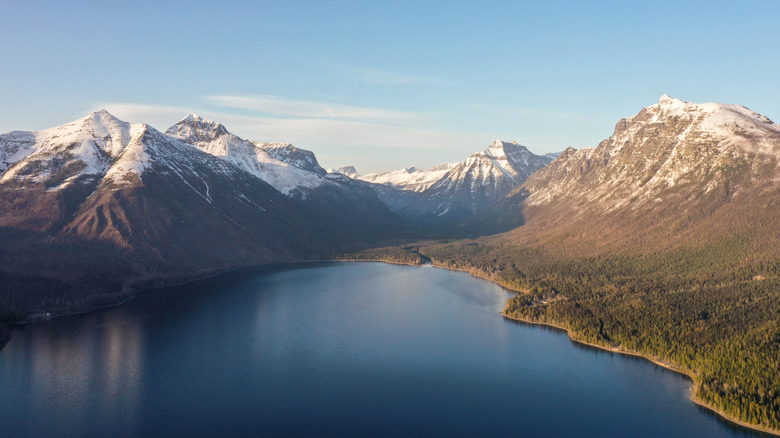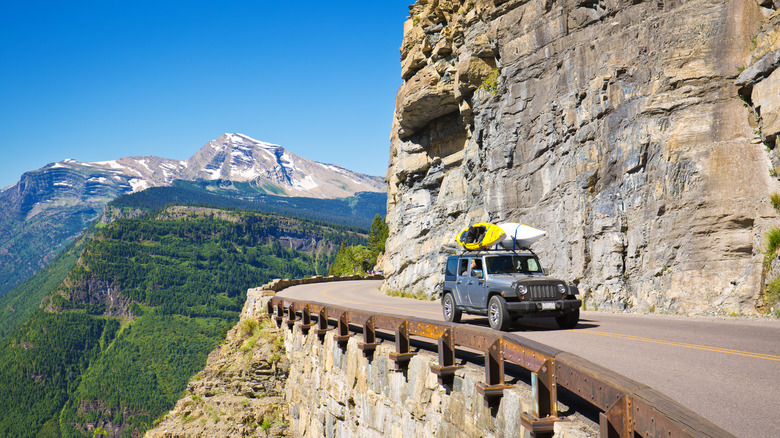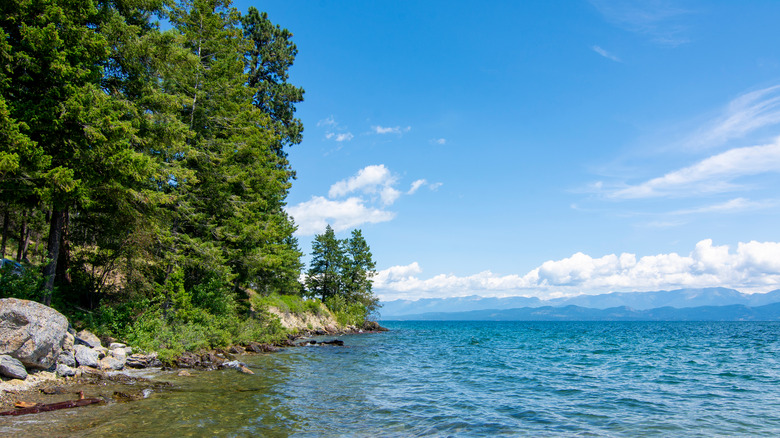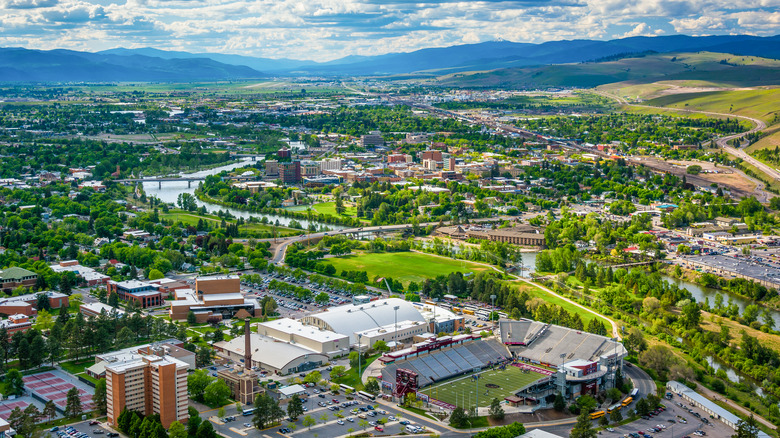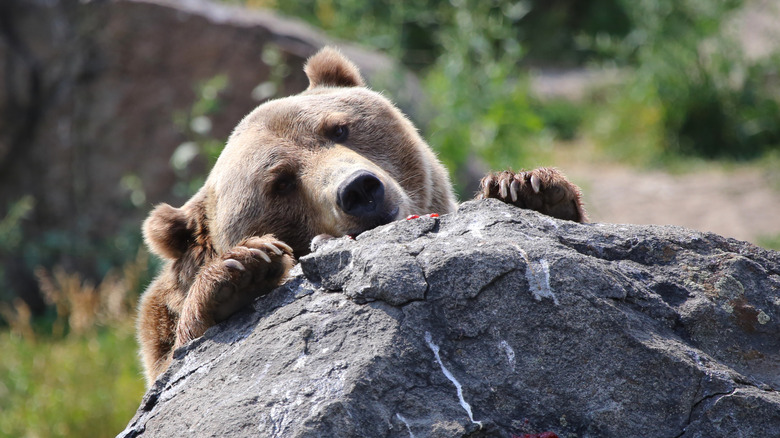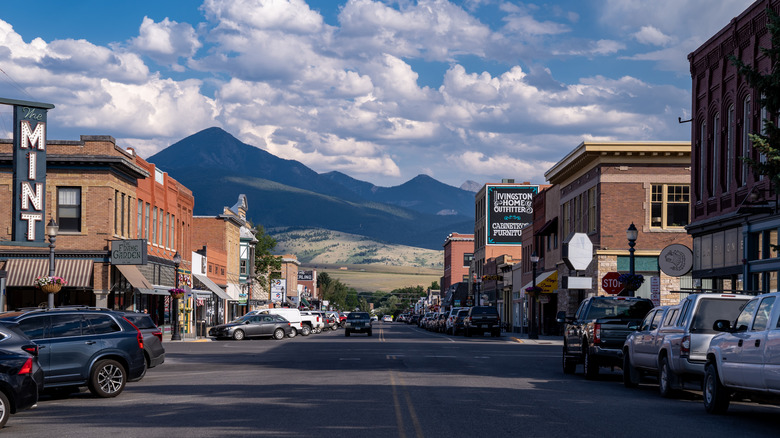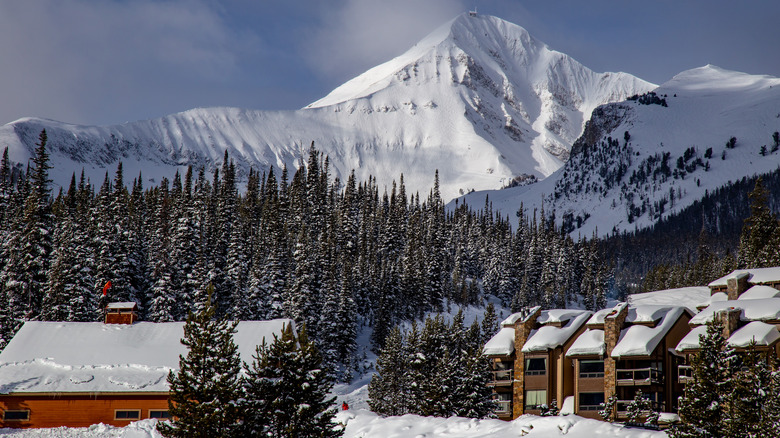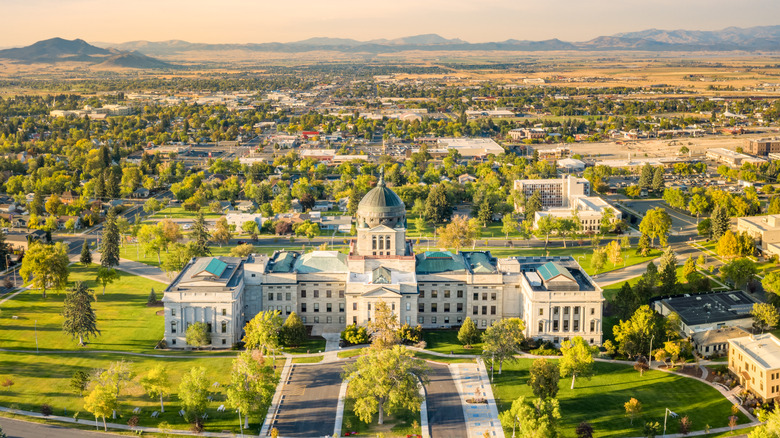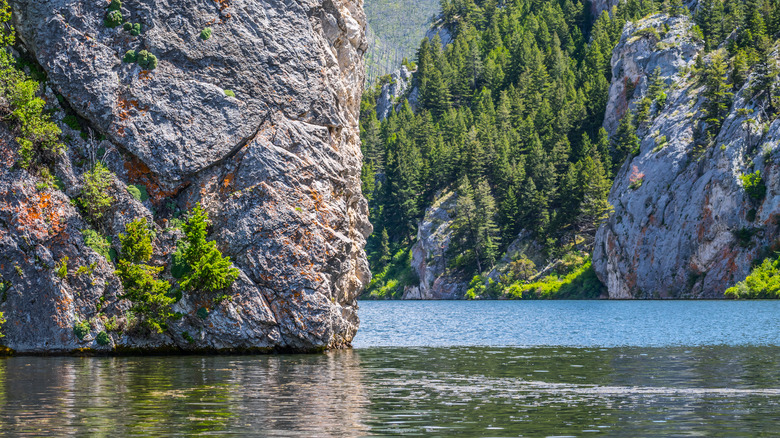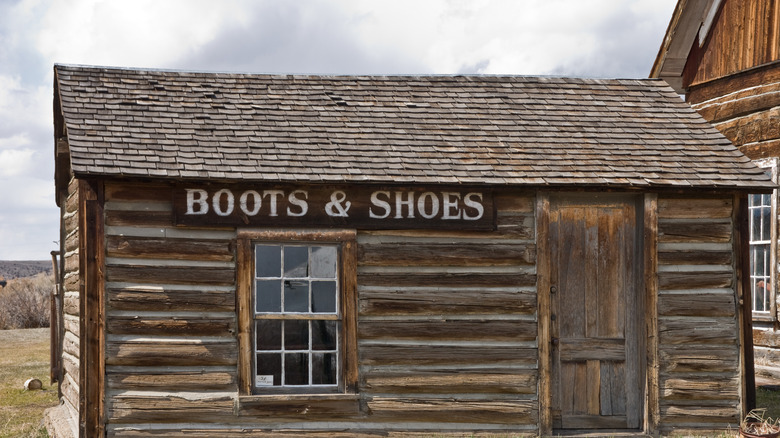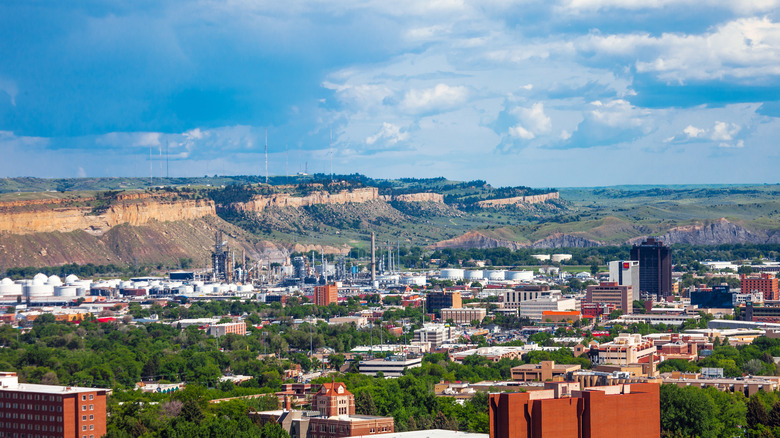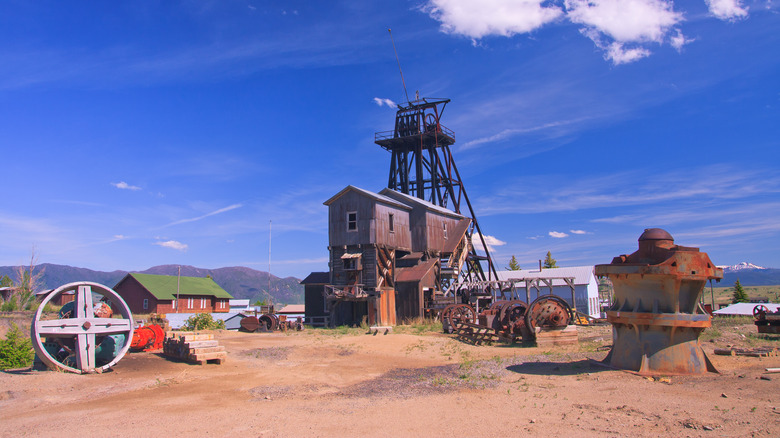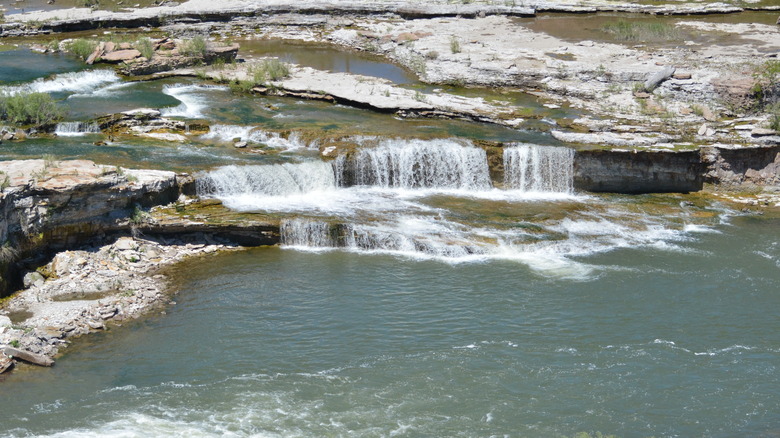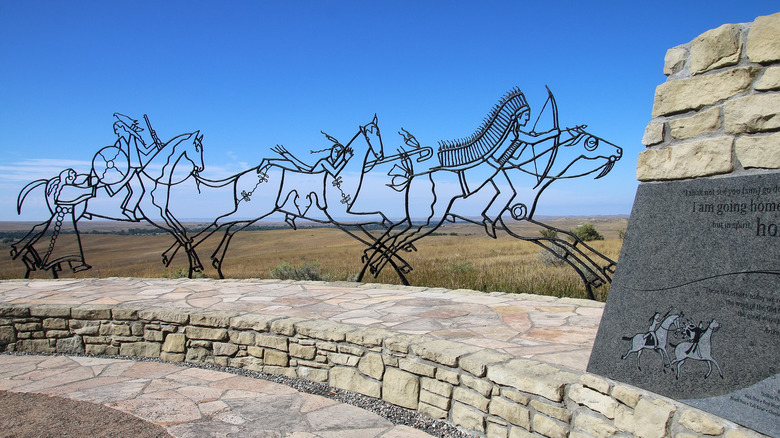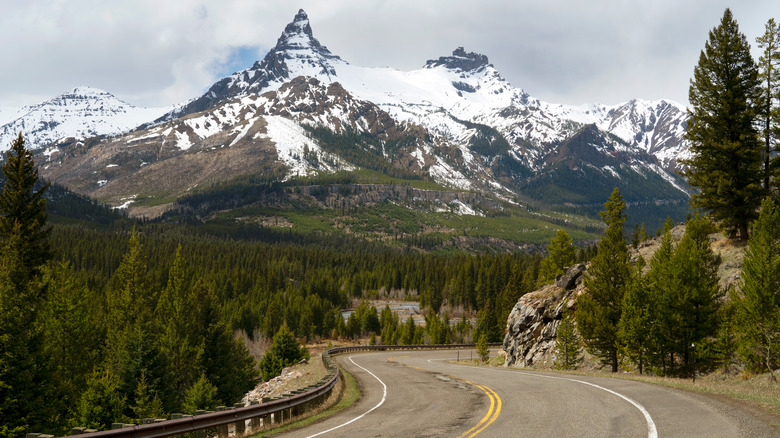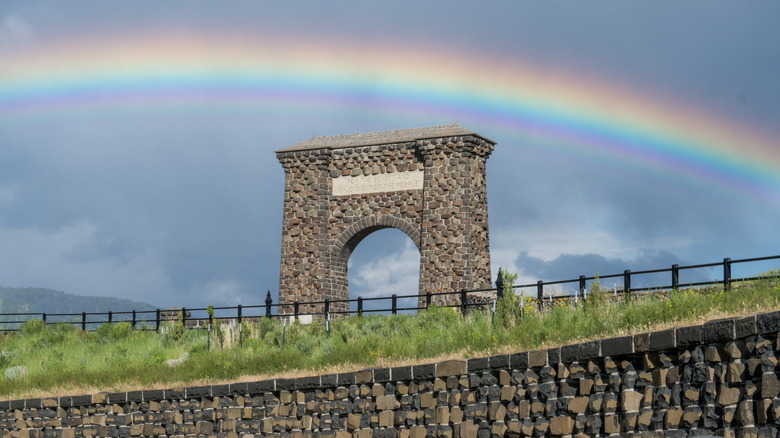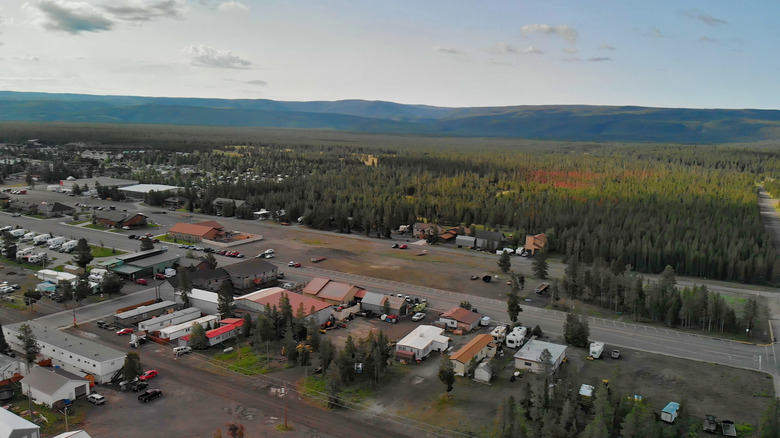16 Must-Visit Spots In Montana
Montanans refer to their state as "the last best place." It's easy to see why, as it has a long list of attributes featuring everything from national and state parks, wildlife, culture, arts, events to historical sites, Old West charm, college towns, hospitality, great food, and wide open spaces. Montana ranks as the fourth largest U.S. state based on the area it covers but in the lowest 10 by population. National forest acreage outnumbers people there — a serious understatement.
The Treasure State serves as a paradise for outdoor recreation all year. Among the best states for hiking during the summer, you'll also find spectacular skiing, snowmobiling, and ice fishing in Montana in the winter. Put simply, there's never a bad time to visit Montana, but the state is at its best between June and August and the snowy months between December and March. The diverse geology, including parts of the Rocky Mountains and the Great Plains, provides an extensive array of outdoor experiences. Millions of people visit the state's most famous landmark, Glacier National Park to the north, every year. Down south, you'll find part of Yellowstone National Park and gateway towns that make great base camps for exploring Montana and beyond. They call this place Big Sky Country for a reason, after all.
1. Glacier National Park
Known as the Crown of the Continent, Glacier National Park contains around a million acres of stunning glacier-carved scenery in northwest Montana. Dozens of glaciers, picturesque meadows, ancient forests, and rushing waterfalls are just the tip of the iceberg. In summer, cruise the Going-to-the-Sun Road, a celebrity in the engineering world, honored as a National Historic Civil Engineering Landmark. The 50-mile stretch of scenic splendor takes you up and over the Continental Divide. Without pit stops, it's a two-hour jaunt — but plan on stopping.
Viewpoints invite you to channel your inner Ansel Adams. Trailheads offer various options, from short, accessible paths to rugged multi-day expeditions. The park's trails span more than 700 miles. If you prefer water to land, the area boasts over 700 lakes and 500 streams. You can fish, boat in motorized and non-motorized vessels, brave the whitewater rapids, or just float like a lazy river connoisseur. Whether traversing by car, boot, or boat, keep a lookout for the A-listers of the animal kingdom: Elk, mountain goats, bighorn sheep, and grizzly bears roam the park.
Glacier National Park is open year-round, but many of its roads, businesses, and amenities take a snow day — or rather snow months come winter. If you like snow and solitude, it's a beautiful setting for snowshoeing and cross-country skiing. Expect companionship from white-tailed deer and white-tailed ptarmigans. These birds take white-out conditions to a new level — their brown feathers turn white to camouflage them in the abundant snow.
2. Flathead County
Glacier National Park is known for its splendor, but the scenic beauty and outdoor recreation options don't end at the park's gate. Adjacent to the park, you'll find a trio of must-visit cities in Flathead County. Columbia Falls waits just under 30 minutes away. It's an excellent home base for your park adventures. Picture a quaint downtown with charming shops, mouth-watering eateries, and a beer garden with live music. For the fun-seekers, check out the water park and zipline course during summer, and look for snowmobile thrills when the snow falls.
Travel just a tad over half an hour from the park's West Entrance, and you are in Whitefish, tucked between Whitefish Lake and Whitefish Mountain Resort. This isn't just any resort — with more than 3,000 skiable acres, it's one of the largest ski resorts in North America. Come summer, enjoy scenic lift rides, hiking, mountain biking, an aerial adventure park, and Montana's only alpine slide. You'll also find charming shops, foodie-approved restaurants, and plenty of lodging options in Whitefish.
For a bigger city, head to Kalispell, less than an hour from Glacier's West Entrance. Kalispell also gets you 30 minutes from Flathead Lake, the largest freshwater lake in the western U.S., with plenty of room for sailing, waterskiing, and fishing. Kalispell has a walkable downtown, an up-and-coming food scene, and a mix of local stores and chains. It makes an ideal base camp, combining all the conveniences you could need near all the recreation you could want.
3. Missoula
Tucked in the heart of the northern Rockies, Missoula is a vibrant university town. At the foot of Mount Sentinel, the University of Montana is the gateway to the famous "M" trail. Hike up this path for views of the Clark Fork River surrounded by the valley and mountains beyond, showing off Missoula's outdoor playground.
In warmer months, fill your days with fishing, rafting, kayaking, hiking, or mountain biking. Once the area turns snowy in the winter, strap on some downhill or cross-country skis or go ice fishing. When you're ready to warm up, numerous breweries or cozy coffee spots will welcome you. Culinary delights abound, from gourmet restaurants to the cheap eats you'd expect to find in a college town. Look for food trucks in the parks and around the city in non-winter months. You'll also find farmer's markets, art walks, makers fairs, and an eclectic music scene.
There's plenty to do in Missoula's city limits, but it's also an excellent launchpad for unique day trips. Less than an hour away lies the Bison Range, a wildlife refuge managed by the Confederated Salish and Kootenai Tribes. Embark on an auto tour to spot bison and other wildlife against a backdrop of epic mountain views. For a hands-on adventure, delve into sapphire mining at Gem Mountain, about an hour and a half outside of Missoula.
4. Bozeman
Bozeman has blossomed recently — when you visit, you'll quickly grasp the reason behind its growth. Beautiful mountains surround its thriving downtown, while concerts and events fill the city's calendar. You'll find outdoor recreation in every direction — it's a hiker and biker's paradise in the summer and just an hour's drive from world-class ski resorts in the winter.
Bozeman makes a great couples getaway for nature lovers and offers plenty of family fun. Visit the Museum of the Rockies, where life-size dinosaur skeletons tower above you. You can also explore distant galaxies in the museum's planetarium. Enjoy the thrill of seeing bears up close at the Montana Grizzly Encounter, a sanctuary dedicated to rescuing and educating about grizzly bears.
Less than an hour's drive from Bozeman, dare to venture into Lewis and Clark Caverns State Park, Montana's first state park. Ranger-guided tours lead you through limestone caverns. When you reemerge, head back to Bozeman to keep exploring — there's much to uncover!
5. Livingston
A year-round destination on the banks of the Yellowstone River, Livingston is one of those underrated U.S. cities worthy of your bucket list. It offers a blend of outdoor adventures with a thriving literary and arts scene, so be sure to catch a show in one of its two historic live theatres. Stroll through the kaleidoscope of art galleries. Participate in the area's rich literary heritage by diving into the world of books with author events at quaint bookstores or find your muse in a cozy café, perfect for starting your own literary masterpiece. Enjoy live music in a historic building on Main Street.
Don't miss the Livingston Depot Center, a restored historic railroad depot downtown. Marvel at the building itself, brought to you by the same visionaries who designed New York's Grand Central Station. Enjoy a beautiful courtyard, shops, and community events here throughout the year. The onsite seasonal museum opens from May through September. Also, check out the year-round Yellowstone Gateway Museum along the Lewis and Clark National Historic Trail. Housed in a three-story 1906 schoolhouse, the museum explores the region's history, wildlife, and geology. Some of the museum's artifacts are over 12,000 years old.
6. Big Sky
Montana is known as "Big Sky Country," where the skies are as limitless as your adventures. Now imagine the place in Montana actually named Big Sky. You'll find this location in southwest Montana, halfway between Bozeman and Yellowstone National Park — just an hour's drive from either destination. Surrounded by national forests, it's a haven for year-round outdoor recreation.
At the heart of Big Sky lies its crown jewel, Big Sky Resort, Montana's luxury ski destination. Unlike other spots in the state, you won't find Big Sky on lists of the best affordable ski vacations in the U.S., but you will find plenty of snow — an average of 400 inches fall every year — and some of the most incredible terrain in the country. With nearly 6,000 acres for turning and carving, options abound for all skill levels. About half the terrain is suited for beginners and intermediate skiers and riders, and the other half is advanced to epic, including some rated as "triple black." This place has good reason to be Montana's seasoned skier's secret destination, with challenging slopes and short to non-existent lift lines.
The resort transforms into a place for summer fun as the seasons change. Enjoy mountain biking on lift-served trails, scenic lift rides, ziplining adventures, and hiking. Golf enthusiasts will find sweeping views on an 18-hole par 72 golf course designed by Arnold Palmer. Just be careful not to airmail the green — at 6,500 feet above sea level, the ball travels far.
7. Helena
History, modern culture, and outdoor adventure blend seamlessly in Helena, Montana's vibrant state capital. Stroll through the impressive Capitol Building, which is open year-round for self-guided tours. Immerse yourself in the building's rich history, admire fine art, and explore its classical design. Take a step back in time with Helena's Walking Tours app, where the Old West springs to life. Wander amidst 19th-century architecture, historic landmarks, mansions, museums, and galleries, which all make up the unique story of Helena.
The Cathedral of St. Helena is a place of prayer, but visitors are welcome year-round for self-guided tours outside Mass times. Guided tours are also available on select days during summer. Built in the early 1900s, the bishop who conceived the Cathedral of St. Helena hoped to create a "symphony of color and light" that would match the cathedrals of Europe. A near replica of the Votive Church of Vienna, visitors marvel at towering twin spires adorned with gold-leafed crosses, nearly 60 stained glass windows, and marbled statues and altars. This grand building was added to the National Register of Historic Places in 1980.
However, Helena isn't just about the past. It's a city pulsating with contemporary thrills. Venture to the Blue Jewel Mine, an operational sapphire mine open in the spring. Catch some live music downtown. Outdoor enthusiasts may have heard of a hiker's paradise; however, Helena offers hiker's convenience, with 75 miles of trails starting right from downtown. And your options grow from there with the Helena National Forest just outside the city.
8. Gates of the Mountains
About 20 miles north of Helena is a stunning river canyon called the Gates of the Mountains. When Captain Lewis of the Lewis and Clark Expedition witnessed the Missouri River carving through towering limestone cliffs in 1805, he said, "This evening we entered much the most remarkable clifts that we have yet seen. these clifts rise from the waters edge on either side perpendicularly to the hight [sic] of 1200 feet." It's hard to choose the top natural wonder in every state, especially in Montana, which has so many great options. But, as you can tell from Lewis' reaction, the Gates of the Mountains might take that spot.
The best way to experience this wonder is on a boat tour. Glide through the waters to see up-close views of rugged rock formations, wooded slopes, and wildlife. Look up, and you might spot bighorn sheep and mountain goats navigating the steep cliffs. While looking up, keep your eyes peeled for the majestic flight of eagles, falcons, and ospreys. These tours, which typically last two hours, launch from the Gates of the Mountains Marina. Available from late May through September, they offer an unforgettable experience in one of Montana's most magnificent landscapes.
9. Virginia City and Nevada City
When gold was discovered in 1863 here, word traveled fast. People flocked to what's now known as Virginia City and Nevada City. Virginia City grew into a booming town, home to the state's first public school, its first newspaper, and was even the state's capital for 10 years. But as the profitability of gold mining faded, so did the crowds. Families and miners fled this isolated area in search of new opportunities, leaving behind homes, stores, and saloons. Many original buildings remain standing and have been restored, ready for your visit. The area is a living museum, open the entire year, transporting you to the heart of pioneer life. Every state has a must-see historic town, and Virginia City is Montana's.
Nevada City, about a mile and a half away from Virginia City, offers more of a curated form of historical preservation. While many original log buildings remain, historic buildings preserved from other locations were also brought in, creating an Old West outdoor museum. Known for its extensive and comprehensive offering of Old West artifacts, a collection rivaled only by those in the Smithsonian, Nevada City showcases the tools, vehicles, and everyday items used in frontier towns. Music Hall also houses a large collection of rare historic music machines, such as player pianos and an automatic violin. Open only during summer, Nevada City comes into full glory on warm weekends, with live reenactments and demonstrations bringing the gold rush era to life.
10. Billings
Visit Billings, the state's largest city, affectionately known as the "City Beneath the Rimrocks." These Rimrocks, or "Rims" for short, are sandstone formations towering up to 800 feet. Billings' intricate network of trails and parks gives you various options for exploring the Rims. For a leisurely journey, the Skyline Trail offers an accessible 7-mile paved path. For a more challenging route, hike atop the Rims at Zimmerman Park.
Beyond the Rimrocks, your options range from peeking back 2,000 years to immersing yourself in the urban charm of Billings' contemporary downtown. Just five minutes from downtown, you can explore rock art that's over 2,000 years old at Pictograph Caves State Park. A short loop to the caves includes interpretive signs elaborating on the park's natural features and the prehistoric paintings. Or, for a very different trail experience, check out the Billings Brew Trail. This relatively flat and paved 1.5-mile loop meanders through downtown, showcasing Montana's finest breweries, distilleries, and a cider mill.
Billings prides itself on its abundant activities and cultural attractions throughout the year. Connect with animals at ZooMontana, an Association of Zoos & Aquariums-accredited zoo caring for rescued wildlife. See how the other half lived at Moss Mansion, a historic house museum with both self and guided tours. Catch a show at the Alberta Bair Theater downtown. Its offerings range from classical symphony music to country western to comedy acts. No matter when you visit, there's always plenty to see and do in Billings.
11. World Museum of Mining
Mining aficionados, this one is for you. Scratch that; the World Museum of Mining is a must for anyone who happens to be in or near Butte, Montana. With over 50 exhibit buildings and more than 60 mine yard displays spread across an inactive silver and zinc mine with the curious moniker "Orphan Girl," the museum expertly tells the history of mining in this much-explored part of the country.
When the museum was founded in 1963, Butte's days as a mining center were still fresh in the memories of the city's residents. The first visitors arrived in 1965, and it has been all hands to the pump ever since, as the streets of the fabulously named Hell Roarin' Gulch tell the story of what was once one of the world's most productive copper mines. Mining in Butte might be a thing of the past, but its legacy and influence on the town are clear.
A visit to the World Museum of Mining is surprisingly affordable. An underground tour of the mine costs just $25, a pittance for the opportunity to see one of the few exposed veins remaining in North America. General admission to the museum costs $12 for adults ($10 for children), which gets you a day of exploration and education unlike any other, an adventure one Tripadvisor user called "a must see if you are in Butte." The mining life was difficult, but a day at the World Museum of Mining is a breeze.
12. Great Falls
Nicknamed "The Electric City" because of its numerous hydroelectric dams on the Missouri River, Great Falls is also known as "Montana's Basecamp for Art & Adventure." Located about halfway between Glacier and Yellowstone National Parks, some travelers breeze through Great Falls, but the city invites you to linger and discover why this place is more than just a road trip pit stop.
Known for its art scene and eclectic museums, Downtown is practically an art gallery with 25 murals. For an enchanting glimpse into Western life, visit the C.M. Russell Museum to see beautiful art that captures the region's culture, landscapes, and wildlife. History buffs will enjoy The History Museum and the Lewis and Clark National Historic Trail Interpretive Center. Learn about trains and planes at the Montana Museum of Railroad History and the Malmstrom Museum and Air Park. Kids will appreciate a museum made for them — the Children's Museum of Montana is the state's oldest and largest such museum.
Check out two spectacular state parks when you're ready to get outside. Just 10 minutes from downtown, explore Giant Springs State Park to see one of the largest freshwater springs in the U.S. Trails through the park connect to the larger River's Edge Trail System, a nearly 60-mile network of trails along the Missouri River. A 30-minute drive from Great Falls takes you to Tower Rock State Park. Named for a 424-foot-high igneous rock formation, the park offers trails with exhibits about the area's history and geology.
13. The Little Bighorn Battlefield National Monument
An area of somber memory, the Little Bighorn Battlefield National Monument pays homage to the lives lost in the famous battle between the U.S. Army and the warriors of the Lakota, Arapaho, and Cheyenne nations. The battle took place on June 25 and 26, 1873, and resulted in a victory for the native soldiers, with U.S. Lt. Officer George A. Custer among those who perished. To many, the battle is remembered as Custer's Last Stand.
Reminders of the battle receive most of the attention at the monument, with Custer National Cemetery, the 7th U.S. Cavalry Memorial, and the Indian Memorial at the top of that list. However, the rugged terrain makes this spot worth a visit in itself. Elsewhere, the 4.5-mile tour to the Reno-Benteen Battlefield is a must, while the museum and bookstore provide context and further reading material on one of the most impactful battles in modern American history.
The Little Bighorn Battlefield National Monument is 61 miles east of Billings, accessed via I-90E. Alternatively, the Visit Montana website has a curated three-day trip from the state capital to the site, a tour covering 295 miles and incorporating Pictograph Cave State Park and Rosebud Battlefield State Park, and much more.
14. Cooke City
Cooke City is a scenic small town just 10 minutes from the Northeast Entrance Station to Yellowstone National Park. Here, you can find cozy accommodations and campsites at rates that are a pleasant surprise compared to those inside the park. But Cooke City is more than just a basecamp for visiting Yellowstone National Park on a budget. You'll also find spectacular scenery driving away from Yellowstone's entrance gate.
The infamous Beartooth All-American Road (U.S. 212), open seasonally, connects Cooke City to Red Lodge on a winding, awe-inspiring 64-mile route. The road travels through multiple national forests with views of glaciers, snowcapped mountains, and alpine lakes. Reaching heights of nearly 11,000 feet, this drive is not for the faint of heart. For the adventurous, it's a memorable trip with abundant options for outdoor recreation along the way. Enjoy hiking, fishing, horseback riding, and even cross-country skiing in June and July. And when winter takes over the road, it becomes a snowmobiling paradise, part of the reason Cooke City is known as one of the best places for snowmobiling in the country.
15. Gardiner
Gardiner makes an excellent jumping-off point for outdoor adventures. The town was the first entrance to Yellowstone National Park — marked with the iconic Roosevelt Arch and now known as the North Entrance, it stays open year-round. With the Yellowstone River running through town, you're always close to fishing, rafting, and swimming. Gardiner's historic downtown is just a few blocks. It's small enough for a laid-back feel while offering enough shops, restaurants, and lodging options. A small but vibrant community hosts various events and festivities throughout the year.
Public lands surround Gardiner. Explore the Absaroka and Beartooth Mountain Ranges. Hike, bike, or go horseback riding in the summer. Snowshoe and enjoy cross-country skiing in the winter. Every season is a great time for wildlife viewing. Balance outdoor adventures with relaxing hot springs. A short, 10-minute drive from Gardiner takes you to Yellowstone Hot Springs. Soak in mineral-rich waters while enjoying mountain views. A scenic, 40-minute drive through Paradise Valley leads you to Chico Hot Springs Resort & Day Spa. Day passes are available year-round for two open-air natural mineral hot springs pools.
16. West Yellowstone
West Yellowstone is the closest town to Yellowstone National Park. You'll be minutes away from Old Faithful, the Grand Canyon of Yellowstone, and other natural wonders, but West Yellowstone is more than just a convenient place to sleep and eat — it's a bustling town with a vibrant community. The Museum of the Yellowstone, open seasonally, shares travel history in and around Yellowstone Park. You'll also find art shows, historical reenactments, and cultural events throughout the year.
If you're looking for outdoor recreation, you're not limited to Yellowstone National Park — you also have three national forests nearby with abundant options for outdoor fun. World-class fishing, hiking, and Nordic skiing are all nearby. West Yellowstone also makes an excellent place for wildlife viewing year-round. For some guaranteed animal sightings, visit the Grizzly & Wolf Discovery Center to see bears, wolves, river otters, and more. The center is open all year, and any season is a good time for a visit. The bears don't hibernate, and the center has indoor and outdoor viewing options.
